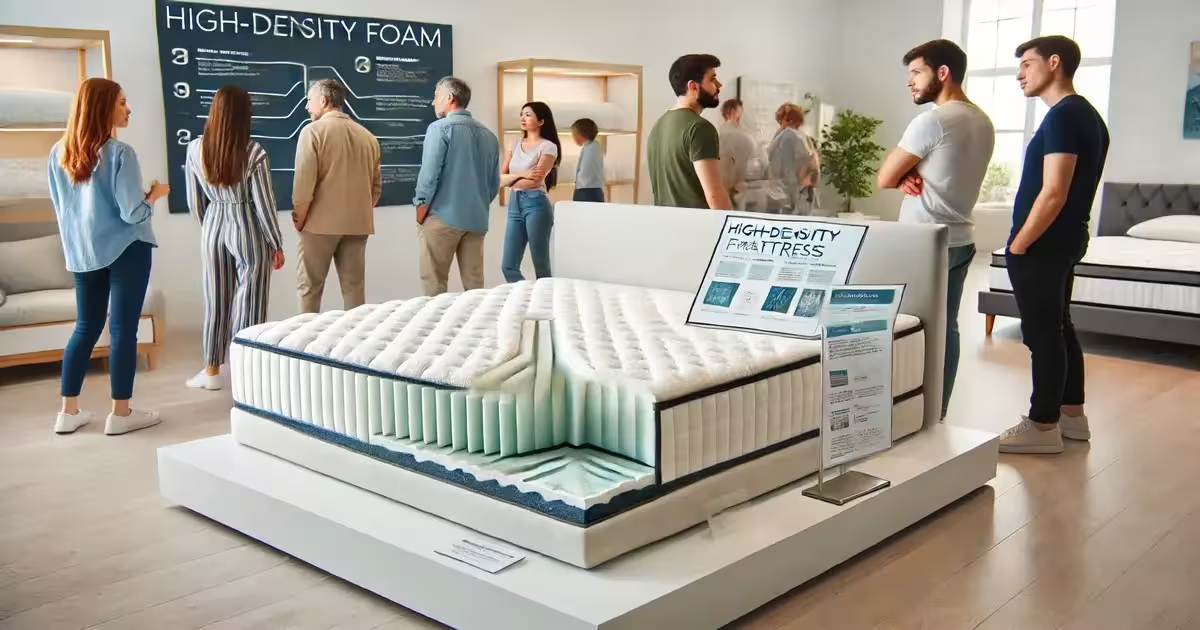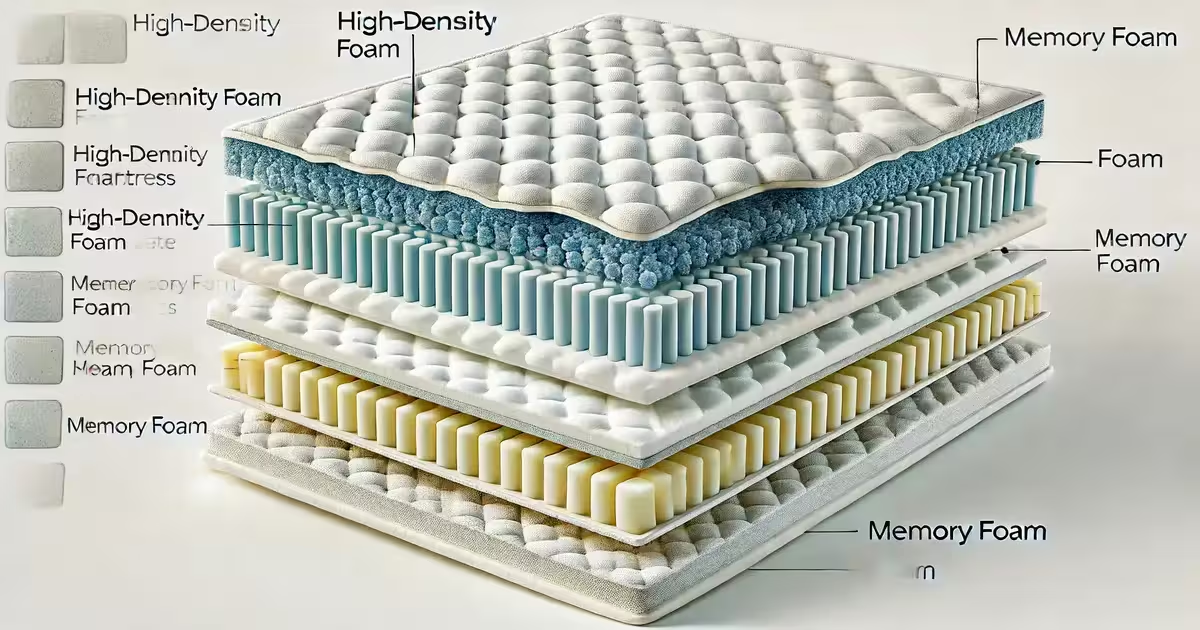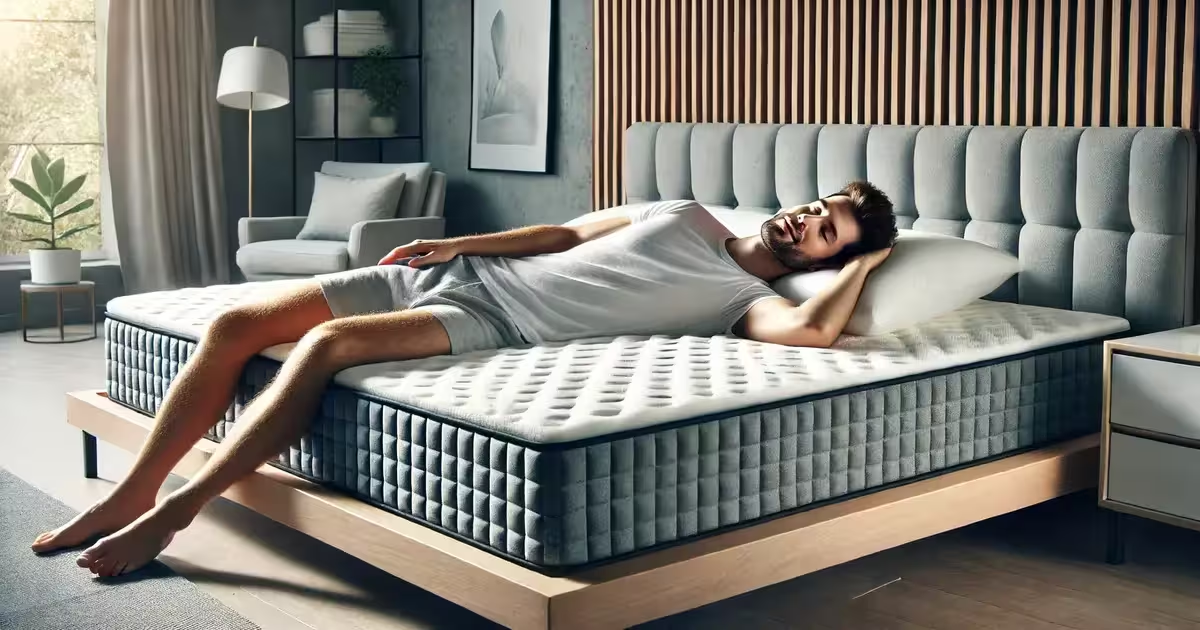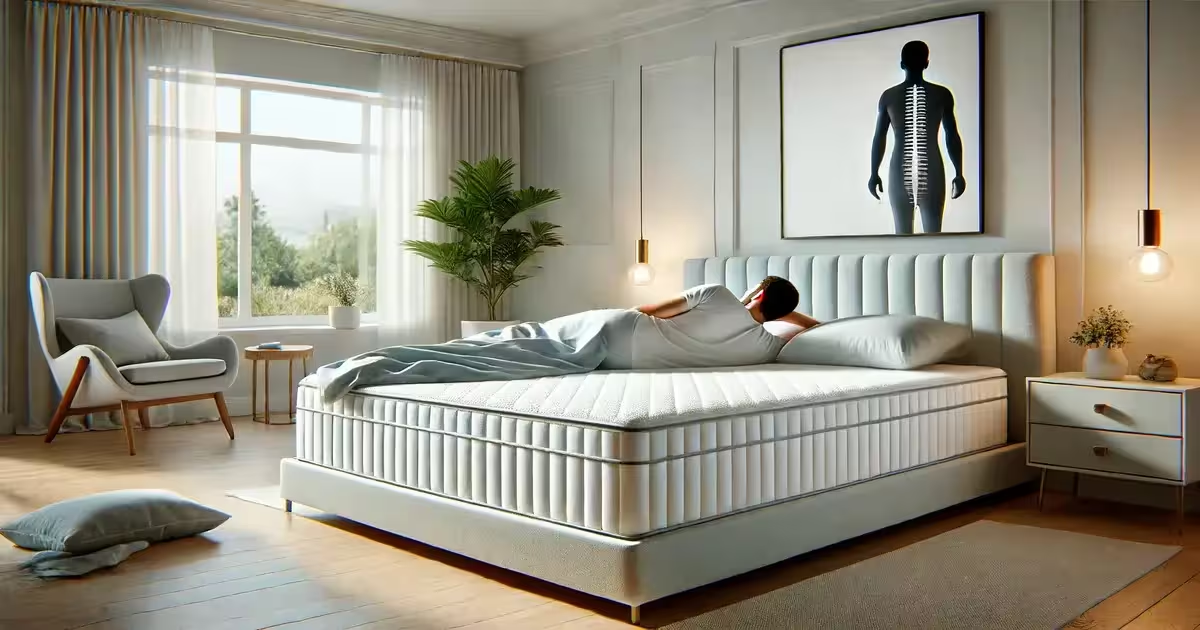High-Density Foam Mattress: The Ultimate Guide for a Firm Sleep Surface

When it comes to choosing a mattress, the material and density can make all the difference in comfort and longevity. High-density foam mattresses are renowned for their superior support and durability, making them an excellent choice for those in search of a firm and supportive sleep surface.
This comprehensive guide will delve into the world of high-density foam mattresses, helping you understand their benefits, compare them with other types, and decide if they’re the right fit for your sleep needs.
What is High-Density Foam?
High-density foam is a specialized type of polyurethane foam known for its dense and compact structure. This density is achieved through a higher concentration of foam cells per cubic foot, making it sturdier and more supportive than lower-density variants.
Here’s a breakdown of what makes high-density foam unique and why it’s a popular choice in various applications:
Key Characteristics of High-Density Foam
Common Uses
High-density foam is a versatile and durable material that offers superior support and longevity, making it ideal for a range of applications from mattresses to furniture.
However, its firmness, potential for heat retention, and higher cost are important factors to consider when deciding if it’s the right choice for your needs. Conducting thorough research and possibly testing the foam in person can help ensure it meets your comfort and support requirements.

Benefits of a High-Density Foam Mattress
Durability
High-density foam mattresses are celebrated for their exceptional durability. According to industry experts, these mattresses are less prone to sagging and are known to maintain their shape and firmness for many years.
This resilience often outlasts lower-density counterparts, offering an extended lifespan that translates to better value for your investment over time. With a high-density foam mattress, you can enjoy the peace of mind that comes with a long-lasting sleep solution without the need for frequent replacements.
Support
Another standout feature of high-density foam mattresses is their remarkable support. The dense structure of these mattresses evenly distributes body weight, effectively alleviating pressure points and reducing the risk of waking up with aches and pains.
This characteristic is particularly beneficial for individuals with back pain or those who require extra support while they sleep. The consistent, reliable support provided by high-density foam mattresses can significantly contribute to a more comfortable and restful sleep experience.
Motion Isolation
For those who share a bed with a partner, the motion isolation properties of high-density foam mattresses are a game-changer. The dense material excels in absorbing movement, ensuring that when your partner tosses and turns, the motion doesn’t ripple across the bed to disturb your slumber.
This feature is highly valued by couples, as it allows each person to enjoy uninterrupted sleep, undisturbed by the movements of their sleeping partner. The motion isolation capabilities of high-density foam mattresses can significantly enhance the overall sleep quality of individuals sharing a bed.
The durability, support, and motion isolation properties of high-density foam mattresses make them an exceptional choice for individuals seeking a long-lasting, supportive, and undisturbed sleep experience. With these remarkable benefits, high-density foam mattresses undoubtedly stand out as a valuable investment in sleep quality and overall well-being.
How Density Affects Mattress Performance
Comfort and Firmness
While high-density foam is often associated with firmness, it’s important to note that density and firmness are not synonymous. High-density mattresses can come in various firmness levels, ranging from soft to very firm.
This variation in firmness is influenced by the mattress’s overall design and the specific layers used. For instance, a high-density mattress may incorporate different foam layers to achieve the desired level of firmness, catering to a wide range of sleep preferences and comfort needs.
Heat Retention
One potential downside of high-density foam is its tendency to retain heat. The tightly packed cells in high-density foam can restrict airflow, leading to a warmer sleep experience. However, many manufacturers have addressed this issue by incorporating advanced cooling gels or open-cell technology in high-density foam mattresses.
These innovations aim to enhance breathability and regulate temperature, mitigating the heat retention associated with high-density foam and providing a more comfortable sleep environment for individuals who are sensitive to warmth.
The density of foam in mattress eshas a significant impact on both comfort and functionality. Understanding the relationship between density and mattress performance can guide individuals in selecting a mattress that aligns with their specific comfort preferences and sleep needs.

Comparing Foam Densities
When choosing a foam mattress, understanding the differences in foam densities is crucial for making an informed decision. Foam density affects not only the comfort and support of the mattress but also its durability and lifespan.
Here, we break down the characteristics of low-density, medium-density, and high-density foams to help you find the best fit for your sleep needs.
Low-Density Foam
Low-density foam mattresses typically have a density of less than 3.5 pounds per cubic foot. These mattresses are softer and may initially feel more comfortable to some sleepers due to their plush, cushiony feel.
This softness can be particularly appealing to those who prefer a more enveloping sleep surface. However, the downside of low-density foam is its lack of durability. The foam cells in low-density mattresses are more widely spaced, making them more susceptible to wear and tear.
Over time, these mattresses tend to break down faster, leading to sagging and a loss of support. This can result in a shorter lifespan, often around 4-6 years, and may not offer the same level of support or longevity as higher-density options.
Medium-Density Foam
Medium-density foam mattresses fall in the range of 3.5 to 5.0 pounds per cubic foot. They strike a balance between softness and support, making them a good middle-ground for many sleepers.
Medium-density foam provides a comfortable sleep surface that is neither too soft nor too firm, which can be ideal for those who find high-density foam too rigid but low-density foam too soft. This type of foam offers better durability than low-density foam, with a typical lifespan of about 6-8 years.
It provides adequate support for most sleep positions, making it a versatile choice for a wide range of sleepers.
High-Density Foam
High-density foam mattresses have a density of more than 5.0 pounds per cubic foot. These mattresses are the most durable and supportive option available. The tightly packed foam cells in high-density foam provide a firm sleep surface that maintains its shape and support over time.
This makes high-density foam ideal for those who need a firm mattress that can withstand prolonged use without sagging or losing its supportive qualities. High-density foam mattresses are particularly beneficial for individuals with back pain or those who require extra support to maintain proper spinal alignment.
They also excel in motion isolation, making them a great choice for couples. With a lifespan of 8+ years, high-density foam mattresses offer long-lasting comfort and support, making them a worthwhile investment for a good night’s sleep.
Choosing between low-density, medium-density, and high-density foam depends on your personal comfort preferences, support needs, and how long your mattress lasts. Understanding these differences can help you select a mattress that provides the best comfort, support, and durability for your unique sleep needs.

Ideal Sleep Positions for High-Density Foam Mattresses
As someone who has spent years helping people find their perfect mattress, I’ve come to appreciate the nuanced way that sleep position affects mattress choice. High-density foam mattresses, with their superior support and durability, can be particularly beneficial for certain sleep positions.
Side Sleepers
For side sleepers like myself, a high-density foam mattress can be a game-changer. It’s all about finding that delicate balance between support and cushioning. We need a mattress that’s firm enough to maintain spinal alignment, preventing the midsection from sinking in and causing strain on the spine.
At the same time, it must provide enough give to cushion the shoulders and hips, which bear the brunt of pressure in this position. High-density foam excels in this regard, cradling the body’s contours while supporting the natural alignment of the spine. It’s this balance that can lead to a restful night’s sleep and a pain-free morning.
Back Sleepers
Back sleepers have different needs. They require a mattress that supports the natural curve of the lower back. A medium-density foam often hits the sweet spot for those who sleep on their backs.
It’s firm enough to prevent the hips from sinking too deeply, which can throw off spinal alignment, yet it has enough softness to conform to the body’s natural curve. This level of tailored support helps alleviate stress on the spine and can contribute to comfortable and restorative sleep.
Stomach Sleepers
Stomach sleepers face a unique challenge. A mattress that’s too firm can create an uncomfortable arch in the back, while one that’s too soft can cause the feeling of being engulfed. Low-density foam tends to serve stomach sleepers best, offering a softer surface that prevents the sensation of being smothered.
It allows for easier breathing and a more neutral spine position, reducing the risk of waking up with lower back discomfort. In my professional experience, I’ve found that while high-density foam mattresses are often touted for their firmness and longevity, they can be surprisingly versatile.
With the right construction, they can cater to side and back sleepers effectively. However, stomach sleepers might need to look for a mattress with a softer top layer to ensure their comfort throughout the night. It’s about understanding your body and how it interacts with the surface you sleep on. That’s the key to unlocking the best sleep of your life.
High-Density Foam vs. Memory Foam
In my years of delving into the intricacies of mattress materials, I’ve often encountered the confusion between high-density foam and memory foam. While they share some characteristics, they are distinct in their composition, behavior, and longevity. Let’s explore these differences to help you make an informed decision when selecting your next mattress.
Composition
Memory foam, a subset of high-density foam, is renowned for its viscoelastic properties. This means it has the unique ability to respond to body heat and pressure, allowing it to contour precisely to the sleeper’s body, providing a personalized sleep experience.
The sensation is often described as a “hug” for your body, which can significantly reduce pressure points and provide a feeling of comfort that’s hard to match. On the other hand, traditional high-density foam is not temperature-sensitive.
It doesn’t contour to the body to the same extent as memory foam. Instead, it offers a more stable and uniform support across the entire mattress surface. This can be particularly beneficial for those who need consistent support, such as individuals with certain back conditions or those who prefer a firmer sleep surface that doesn’t give way under their weight.
Motion Isolation
When it comes to motion isolation, both high-density and memory foam perform admirably, making either a good choice for couples. However, memory foam has a slight advantage due to its ability to conform closely to the body.
This means that when your partner moves during the night, the memory foam absorbs and isolates that motion, preventing it from transferring across the bed and potentially disturbing your sleep.
Durability
Durability is a critical factor to consider when investing in a mattress. High-density foam mattresses are generally more durable than their memory foam counterparts. The denser structure of high-density foam provides a sturdy foundation that resists sagging and maintains its shape over time, leading to a longer lifespan.
Memory foam, while incredibly comfortable and supportive, can be prone to developing body impressions over time, especially if it’s not of the highest quality or if it’s subjected to continuous pressure in the same area.
The choice between high-density foam and memory foam will largely depend on your personal preference for sleep comfort and support. If you’re looking for a mattress that molds to your body, providing a warm, enveloping feel, memory foam might be the way to go.
However, if you prioritize longevity and consistent support, a high-density foam mattress could be the better option. Remember, a mattress is an investment in your sleep health, so consider your options carefully to ensure you make a choice that will offer you the best night’s sleep for years to come.

High-Density Foam vs. Hybrid Innerspring Mattress
When it comes to choosing between high-density foam and hybrid innerspring mattresses, the differences in support and durability play a significant role in determining the best fit for your sleep needs.
Support
High-density foam mattresses provide a solid, uniform support system that is especially beneficial for individuals who require a firm sleep surface to maintain proper spinal alignment. The dense structure of high-density foam ensures that it distributes body weight evenly, reducing pressure points and promoting a restful night’s sleep.
On the other hand, hybrid innerspring mattresses offer a combination of foam comfort layers and supportive springs. The foam layers provide cushioning and contouring, while the supportive springs contribute to a responsive and buoyant feel.
This combination can be advantageous for sleepers who prefer a balance of support and comfort, especially those who enjoy the traditional feel of innerspring mattresses with added foam layers for enhanced comfort.
Durability
In terms of durability, high-density foam mattresses have a clear advantage. The dense composition of high-density foam ensures that it maintains its shape and support for a longer period, resisting sagging and body impressions.
This longevity makes high-density foam mattresses a reliable choice for individuals seeking a mattress that will provide consistent support over time. On the other hand, the coils in hybrid mattresses can eventually sag, especially with prolonged use.
While the foam layers in hybrid mattresses contribute to comfort, the durability of the overall mattress may be compromised over time due to the wear and tear on the coil system.
When considering the choice between high-density foam and hybrid innerspring mattresses, it’s essential to weigh the importance of firm, uniform support and long-term durability against the desire for a responsive and cushioned sleep surface.
Understanding these distinctions can guide you in selecting the mattress that best aligns with your sleep preferences and support needs.
Potential Drawbacks of High-Density Foam Mattresses
While high-density foam mattresses offer exceptional support and durability, there are some potential drawbacks to consider, particularly in terms of heat retention and weight.
Heat Retention
The dense structure of high-density foam can lead to heat retention, which may be uncomfortable for some sleepers, especially those who are prone to feeling warm during the night. Advanced cooling technologies are available to help alleviate this issue.
Many high-quality high-density foam mattresses now incorporate innovative cooling materials and designs to enhance breathability and regulate temperature, providing a more comfortable sleep experience for individuals who are sensitive to heat.
Weight
High-density foam mattresses are heavier compared to lower-density foams, making them more challenging to move or transport. This can be a consideration for individuals who relocate frequently or like to rearrange their bedroom setup. The weight of high-density foam mattresses can pose logistical challenges, especially when it comes to setting up or moving the mattress within the home.
Understanding these potential drawbacks can help you make an informed decision when considering a high-density foam mattress. By weighing the benefits of superior support and durability against these considerations, you can determine if a high-density foam mattress aligns with your sleep preferences and lifestyle.
In conclusion, while high-density foam mattresses offer numerous advantages, it’s essential to consider these potential drawbacks to ensure that the mattress you choose provides the best possible sleep experience for your individual needs.
Conclusion
High-density foam mattresses are an excellent choice for those seeking a firm and supportive sleep surface that lasts. While they may have some drawbacks, such as heat retention and weight, the benefits of durability, support, and motion isolation make them a valuable investment for a restful night’s sleep.
By understanding the nuances of high-density foam, you can make an informed decision that aligns with your personal sleep preferences and ensures comfort and support for years to come.

Yanie Wijaya
CFO @ wijayafoam.com
Yanie Wijaya is a leading expert in the foam mattress industry with over 15 years of experience. As the owner of Wijaya Foam and key brands like Asia Deluxe and Eversoft Rebonded, she has shaped mattress manufacturing across Southeast Asia. Outside of her professional life, Yanie enjoys motherhood and Korean cinema. Her deep industry knowledge makes her a trusted authority in foam mattress innovation.

